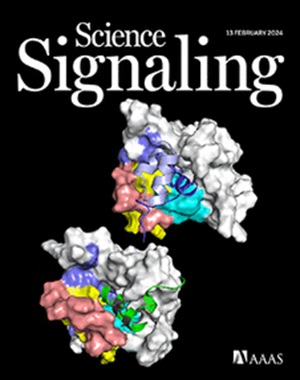一种诱导microRNA miR-124的药物能够分化抗维甲酸的神经母细胞瘤细胞
IF 6.6
1区 生物学
Q1 BIOCHEMISTRY & MOLECULAR BIOLOGY
引用次数: 0
摘要
神经母细胞瘤是一种由神经嵴源性祖细胞引起的儿科癌症,其肿瘤细胞异质性提出了临床挑战。与肾上腺素能(ADRN)神经母细胞瘤细胞不同,具有间充质(MES)特性的神经母细胞瘤细胞对化疗和类维甲酸治疗具有耐药性,这导致复发和治疗失败。我们探讨了神经源性肿瘤抑制microRNA miR-124的上调是否能促进维甲酸耐受性MES神经母细胞瘤细胞的分化。利用我们对mirna调节小分子的筛选,我们鉴定并验证了酪氨酸和磷酸肌肽激酶抑制剂PP121作为miR-124的强效诱诱剂。联合PP121和激活bdnf的蟾毒灵协同抑制增殖并促进MES/异质SK-N-AS细胞持续分化数周。该方案还导致了多发性MES神经母细胞瘤和胶质母细胞瘤细胞系的分化。分化的MES/异质SK-N-AS细胞的RNA-seq分析显示,ADRN核心调控回路被与染色质细胞和雪旺细胞前体相关的回路所取代。此外,分化与CDK4/CDK6通路的抑制和转录程序的激活有关,这与神经母细胞瘤患者预后的改善有关。我们的发现提示了一种具有翻译潜力的方法来诱导神经系统治疗抵抗性癌症的分化。此外,这些长寿的分化细胞可以用于研究癌症生物学和治疗的机制。本文章由计算机程序翻译,如有差异,请以英文原文为准。

A drug that induces the microRNA miR-124 enables differentiation of retinoic acid–resistant neuroblastoma cells
Tumor cell heterogeneity in neuroblastoma, a pediatric cancer arising from neural crest–derived progenitor cells, presents clinical challenges. Unlike adrenergic (ADRN) neuroblastoma cells, neuroblastoma cells with a mesenchymal (MES) identity are resistant to chemotherapy and retinoid therapy, which contributes to relapses and treatment failures. We explored whether up-regulation of the neurogenic, tumor suppressor microRNA miR-124 could promote the differentiation of retinoic acid–resistant MES neuroblastoma cells. Leveraging our screen for miRNA-modulatory small molecules, we identified and validated the tyrosine and phosphoinositide kinase inhibitor PP121 as a robust inducer of miR-124. Combining PP121 and BDNF-activating bufalin synergistically arrested proliferation and promoted the sustained differentiation of MES/heterogeneous SK-N-AS cells over several weeks. This protocol also resulted in the differentiation of multiple MES neuroblastoma and glioblastoma cell lines. RNA-seq analysis of differentiated MES/heterogeneous SK-N-AS cells revealed the replacement of the ADRN core regulatory circuitry with circuitries associated with chromaffin cells and Schwann cell precursors. Furthermore, differentiation was associated with inhibition of the CDK4/CDK6 pathway and activation of a transcriptional program that correlated with improved outcomes for patients with neuroblastoma. Our findings suggest an approach with translational potential to induce the differentiation of therapy-resistant cancers of the nervous system. Moreover, these long-lived, differentiated cells could be used to study mechanisms underlying cancer biology and therapies.
求助全文
通过发布文献求助,成功后即可免费获取论文全文。
去求助
来源期刊

Science Signaling
BIOCHEMISTRY & MOLECULAR BIOLOGY-CELL BIOLOGY
CiteScore
9.50
自引率
0.00%
发文量
148
审稿时长
3-8 weeks
期刊介绍:
"Science Signaling" is a reputable, peer-reviewed journal dedicated to the exploration of cell communication mechanisms, offering a comprehensive view of the intricate processes that govern cellular regulation. This journal, published weekly online by the American Association for the Advancement of Science (AAAS), is a go-to resource for the latest research in cell signaling and its various facets.
The journal's scope encompasses a broad range of topics, including the study of signaling networks, synthetic biology, systems biology, and the application of these findings in drug discovery. It also delves into the computational and modeling aspects of regulatory pathways, providing insights into how cells communicate and respond to their environment.
In addition to publishing full-length articles that report on groundbreaking research, "Science Signaling" also features reviews that synthesize current knowledge in the field, focus articles that highlight specific areas of interest, and editor-written highlights that draw attention to particularly significant studies. This mix of content ensures that the journal serves as a valuable resource for both researchers and professionals looking to stay abreast of the latest advancements in cell communication science.
 求助内容:
求助内容: 应助结果提醒方式:
应助结果提醒方式:


